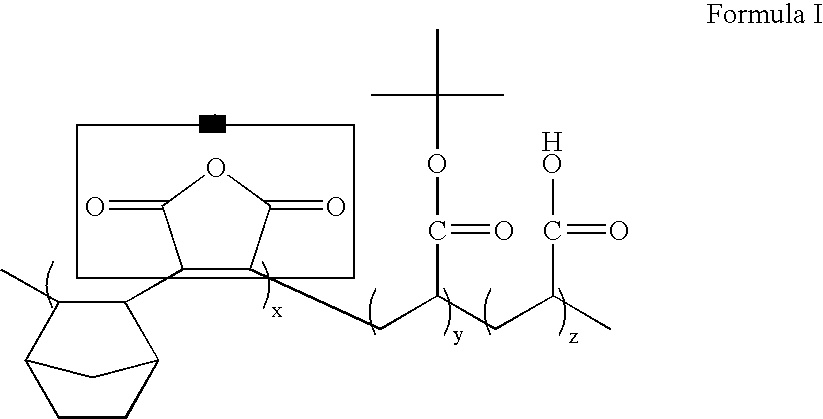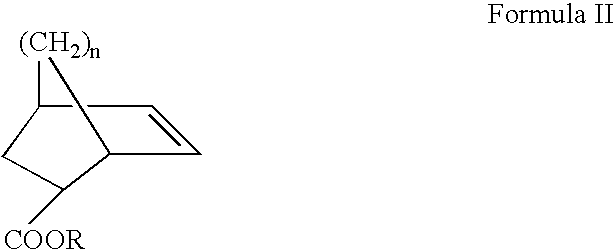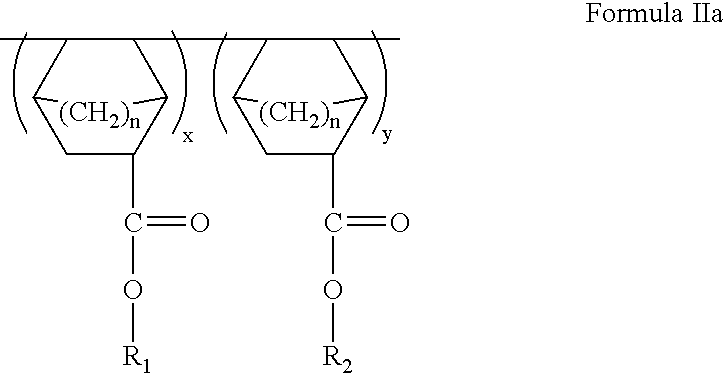ArF photoresist copolymers
- Summary
- Abstract
- Description
- Claims
- Application Information
AI Technical Summary
Benefits of technology
Problems solved by technology
Method used
Image
Examples
example i
Synthesis of 2-hydroxyethyl 5-norbornene-2-carboxylate
Dicyclopentadiene of the following formula V was cracked at about 120-170° C., thereby obtaining cyclopentadiene of the following Formula VI.
Cyclopentadiene of Formula VI and 2-hydroxyethylacrylate of the following Formula VII are dissolved at the same rate in ether or tetrahydrofuran and reacted at a temperature of about −30 to 60° C. for 24 hours. Thereafter, the solvent is removed by use of a rotary evaporator and the residue is distilled in vacuo to give 2-hydroxyethyl 5-norbornene-2-carboxylate of the following Formula VIII, which occurs in an endo- and exo-mixture.
example ii
Synthesis of t-butyl 5-norbornene-2-carboxylate
66 g of cyclopentadiene is first put in a reactor and then mixed with 500 g of tetrahydrofuran. 128 g of t-butyl acrylate is added to the reactor. Thereafter, these reactants are subjected to a reaction at a temperature of −30 to 60° C. for 10 hrs with stirring. After the completion of the reaction, the solvent is vaporized in vacuo by use of a rotary evaporator, then vacuum distilled to produce the subject compound: yield is 90%.
example iii
Synthesis of Copolymer
91 g of the 2-hydroxyethyl 5-norbornene-2-carboxylate synthesized in Example I, 97 g of the t-butyl 5-norbornene-2-carboxylate synthesized in Example II, and 86 g of vinylene carbonate are put into a reactor and 182 g of tetrahydrofuran solvent is poured thereto. Then, 5.48 g of azobisisobutyronitrile (AIBN) is added into the reactor. Then, the reactor is purged with a nitrogen atmosphere. A reaction is performed for 6 hrs. at 65-120° C. After the completion of the reaction, a part of the solvent is removed by a rotary evaporator and the residue is precipitated in ethyl ether. The precipitate is filtered and dried in a vacuum oven. The resulting product can be used as a photoresist resin.
PUM
| Property | Measurement | Unit |
|---|---|---|
| Composition | aaaaa | aaaaa |
| Adhesivity | aaaaa | aaaaa |
Abstract
Description
Claims
Application Information
 Login to View More
Login to View More - R&D
- Intellectual Property
- Life Sciences
- Materials
- Tech Scout
- Unparalleled Data Quality
- Higher Quality Content
- 60% Fewer Hallucinations
Browse by: Latest US Patents, China's latest patents, Technical Efficacy Thesaurus, Application Domain, Technology Topic, Popular Technical Reports.
© 2025 PatSnap. All rights reserved.Legal|Privacy policy|Modern Slavery Act Transparency Statement|Sitemap|About US| Contact US: help@patsnap.com



